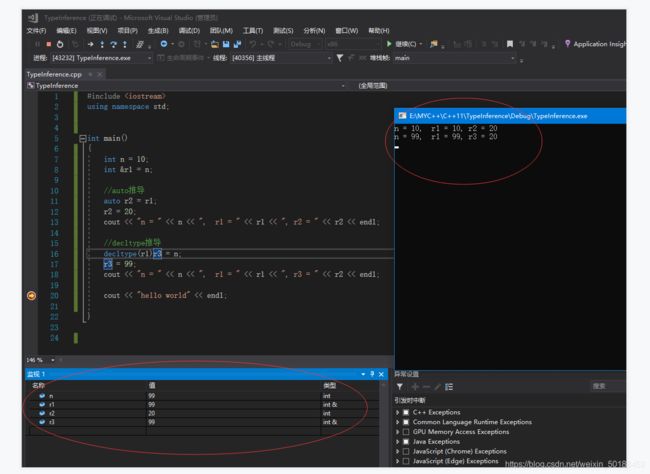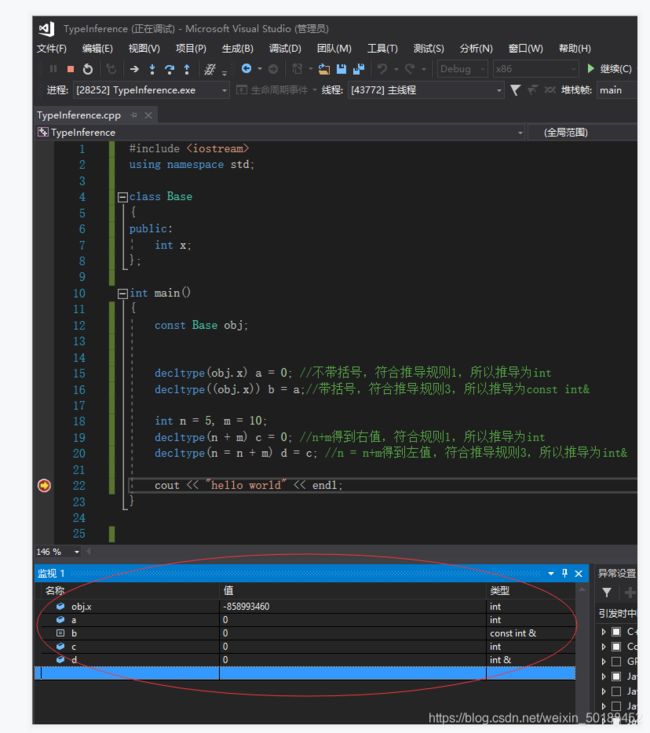C++11类型推导的关键字auto和decltype
他们的语法格式:
auto varname = value;
decltype(exp) varname [= value];
稍微解释一下,看不懂没关系,耐心往下看你就会明白了:
varname 表示变量名,value 表示赋给变量的值,exp 表示一个表达式,方括号[ ]表示可有可无。
auto 和 decltype 都会自动推导出变量 varname 的类型,但是他们都推导方式有些区别:
- auto 根据=右边的初始值 value 推导出变量的类型;所以auto
要求变量必须初始化,也就是在定义变量的同时必须给它赋值,不然会报错的 - decltype 根据 exp 表达式推导出变量的类型,跟=右边的 value 没有关系。 所以decltype 不要求初始化
闲话:
auto 将变量的类型和初始值绑定在一起,而 decltype 将变量的类型和初始值分开;虽然 auto 的书写更加简洁,但 decltype 的使用更加灵活。
先来一个简单的例子:
#include 类型推导对对 cv 限定符的处理
「cv 限定符」是 const 和 volatile 关键字的统称:
- const 关键字用来表示数据是只读的,也就是不能被修改;
- volatile 和const 是相反的,它用来表示数据是可变的、易变的,目的是不让 CPU 将数据缓存到寄存器,而是从原始的内存中读取。
注意:
在推导变量类型时,auto 和 decltype 对 cv 限制符的处理是不一样的。decltype 会保留 cv 限定符,而 auto 有可能会去掉 cv 限定符。
auto 关键字对 cv 限定符的推导规则:
- 如果表达式的类型不是指针或者引用,auto 会把 cv 限定符直接抛弃,推导成 non-const 或者 non-volatile 类型。
- 如果表达式的类型是指针或者引用,auto 将保留 cv 限定符。
类型推导关键字对const限定符的推导例子:
#include 对变量们类型的查看:

这里可以验证,类型推导对指针类型cv 限定符的推导规则。
类型推导关键字对引用推导
例子:
#include 查看变量们的类型:

总结:
可以看出来auto把引用抛弃了,decltype则保留了引用。
闲谈:auto 虽然在书写格式上比 decltype 简单,但是它的推导规则复杂,有时候会改变表达式的原始类型;而 decltype 比较纯粹,它一般会坚持保留原始表达式的任何类型,让推导的结果更加原汁原味。
详细关于auto
我很早之前就写了一篇文章详细介绍了,请点连接。
decltype的具体用法
decltype的由来
既然已经有了 auto 关键字,为什么还需要 decltype 关键字呢?因为 auto 并不适用于所有的自动类型推导场景,在某些特殊情况下 auto 用起来非常不方便,甚至压根无法使用,所以 decltype 关键字也被引入到 C++11 中。
用法:
decltype(exp) varname; //不初始化
decltype(exp) varname = value; //初始化
其中,varname 表示变量名,value 表示赋给变量的值,exp 表示一个表达式。
exp 注意事项
原则上讲,exp 就是一个普通的表达式,它可以是任意复杂的形式(如函数),但是我们必须要保证 exp 的结果是有类型的,不能是 void;例如,当 exp 调用一个返回值类型为 void 的函数时,exp 的结果也是 void 类型,此时就会导致编译错误。
decltype 简单用法的例子:
#include decltype 推导规则
decltype它的玩法实际上可以非常复杂。当程序员使用 decltype(exp) 获取类型时,编译器将根据以下三条规则得出结果:
- 如果 exp 是一个不被括号( )包围的表达式,或者是一个类成员访问表达式,或者是一个单独的变量,那么 decltype(exp) 的类型就和 exp 一致,这是最普遍最常见的情况。
- 如果 exp 是函数调用,那么 decltype(exp) 的类型就和函数返回值的类型一致。
- 如果 exp 是一个左值,或者被括号( )包围,那么 decltype(exp) 的类型就是 exp 的引用;假设 exp 的类型为 T,那么 decltype(exp) 的类型就是 T&。
exp为普通表达式的例子:
#include 查看变量们的类型:

对应推导规则 1,对于一般的表达式,decltype 的推导结果就和这个表达式的类型一致。
exp 为函数调用的例子:
#include 查看变量的类型,发现了一个特例

注意:exp 中调用函数时需要带上括号和参数,但这仅仅是形式,并不会真的去执行函数代码。这里对应这规则2
exp 是左值,或者被( )包围的例子:
#include 补充左值和右值的理解:
左值是指那些在表达式执行结束后依然存在的数据,也就是持久性的数据;右值是指那些在表达式执行结束后不再存在的数据,也就是临时性的数据。有一种很简单的方法来区分左值和右值,对表达式取地址,如果编译器不报错就为左值,否则为右值。
decltype 的实际应用
应用于模板类型编程中的例子:
#include 红色
红色


